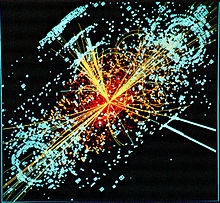Higgs boson Mystery Cache
-
Difficulty:
-

-
Terrain:
-

Size:  (micro)
(micro)
Please note Use of geocaching.com services is subject to the terms and conditions
in our disclaimer.
NOT AT POSTED COORDINATES
This cache is one of six in the Particle Series. Each cache is a stand-alone cache. These caches are inspired by on-going research at CERN labs in Switzerland.
CERN, the European Organization for Nuclear Research, is one of the world’s largest and most respected centres for scientific research. Its business is fundamental physics, finding out what the Universe is made of and how it works. At CERN, the world’s largest and most complex scientific instruments are used to study the basic constituents of matter — the fundamental particles. By studying what happens when these particles collide, physicists learn about the laws of Nature.

A simulated event, featuring the appearance of the Higgs boson
The Higgs boson is a hypothetical massive elementary particle predicted to exist by the Standard Model of particle physics. The existence of the particle is postulated to resolve inconsistencies in theoretical physics and attempts are being made to find the particle by experiment, using the Large Hadron Collider (LHC) at CERN and the Tevatron at Fermilab.
The Higgs boson is the only Standard Model particle that has not been observed in particle physics experiments. It is a consequence of the so-called Higgs mechanism which is the part of the Standard Model that explains how most of the known elementary particles become massive. For example, the Higgs boson would explain the difference between the massless photon, which mediates electromagnetism and the massive W and Z bosons which mediate the weak force. If the Higgs boson exists, it is an integral and pervasive component of the material world.
If it exists, it is of a class of particles known as scalar bosons. Bosons have integer spin and scalar bosons have spin 0. The photon is a kind of boson and so is the less-familiar gluon, along with the W and Z particles mentioned above. These particles are all vector bosons, with spin 1. At present there are no known elementary scalar bosons in nature, although many composite spin-0 particles are known.
Theories exist that do not anticipate the Higgs boson, described elsewhere as Higgsless models. Some arguments suggest that any mechanism which generates the masses of the elementary particles must be visible below 1.4 TeV. Therefore the Large Hadron Collider is expected to provide experimental evidence of the existence or non-existence of the Higgs boson. Experiments at Fermilab also continue previous attempts at detection, albeit hindered by the lower energy of the Tevatron accelerator, although it theoretically has the necessary energy to produce the Higgs boson
To obtain the coordinates for this cache, solve the following puzzle:
Pion -3
Kaon -3
xi baryon
Tau +3
Alpha Particle
Muon neutrino
oxidizing rays
Alpha particle
Proton -6
L0
- 4
Antihydrogen -1
W boson
Z boson
Top quark +1

You can validate your puzzle solution with certitude.
Additional Hints
(No hints available.)